Fresh food should be stored in the fridge or fruit bowl. Anything kept in the fridge should be removed for at least an hour before feeding.
Seed needs to be stored in a cool, dark, dry place, in airtight containers. This will lengthen its shelf life, and will usually (but not always) prevent infestation from flour mites, grain beetles, moths and other unwanted visitors. If you only have a pair of birds, or a single Canary, you won’t need much seed mix at any given time, and a small box of food will suffice. As it will only last two weeks or so, you don’t have to be too paranoid about infestations; but keeping it in an airtight container is still a good habit to get into.
If you’re buying larger quantities for a larger flock of birds, you don’t need specialised bird seed containers. A coloured plastic box or bin with a tight lid is fine, or any other plastic or glass sealed container (although if you are using glass or clear plastic, it must be kept in a dark cupboard or cellar). ‘Wet’ foodstuff – wild seeds collected from weeds in your garden or sprouted from dry seeds – can be frozen in airtight freezer boxes. Don’t leave it hanging around once defrosted, or moulds will start to form; and never refreeze it.
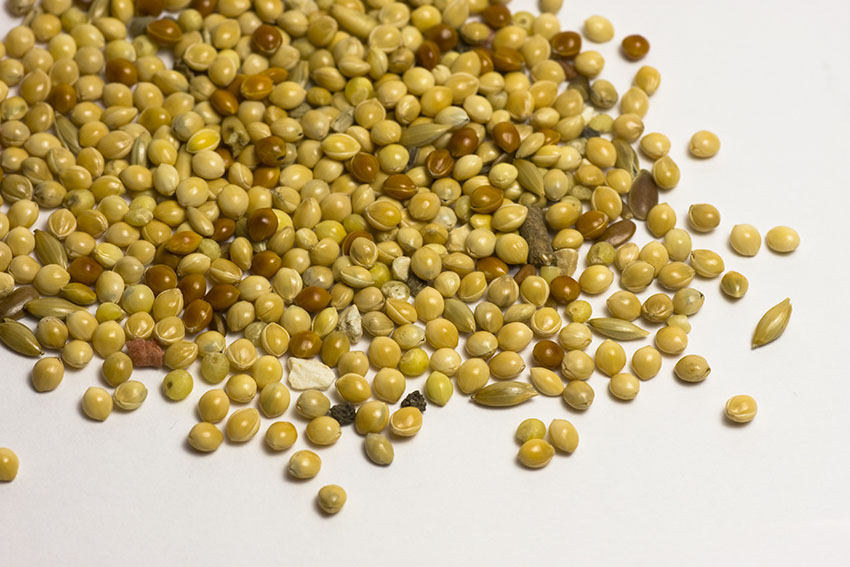
Good storage will give your dry seed a long shelf life
Kept dry, airtight, cool, and away from direct light, a seed and grain mix should stay fresh for up to six months. After that time, even if the grain is still dry, a lot of the vitamins and nutrients will have disappeared. Locking the goodness in by freezing solves the problem, but creates new ones. After defrosting, the seeds will be moist, and this can lead to fungal and bacterial growths, which can make your birds ill. The best option is to avoid buying in bulk – that way your seed will not become old and leached of its goodness.
As mentioned above, if your seeds become damp, mildew can spread quickly. If you see even a faint dusting of mildew on the surface of your batch of seed, or catch a whiff of something mushroomy, you must assume that rot has spoiled the whole batch. Throw it away, and find a drier storage space.
Finch Seed Infestation
As long as your seed is from a reliable source and kept dry, and your fresh food is indeed fresh, you won’t go far wrong. There are one or two things to beware of, though, especially if you are storing dry food in bulk. Not only can fungus or parasites spoil your supplies, but some of these can also cause harm to your birds.
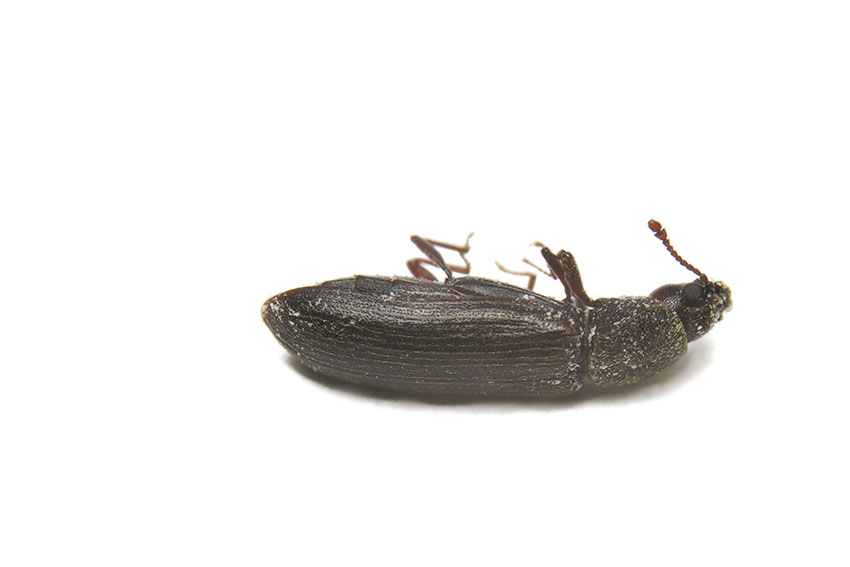
Flour beetles will happily gorge on your bird seed
If you’re not careful when choosing your seed and grain supplier – or if you’re unhygienic or just plain unlucky at home – you might end up with a batch of contaminated food. The eggs and larvae of some common parasites are not always obvious at first glance, and it’s easy to assume that dry seeds and grain must be okay. Beware the cursory glance!
If you can see small creatures crawling through the grain or seed, you’ve got a full-scale invasion of beetles or weevils, or some similar unwanted insect. If the grain smells damp or musty into the bargain, the supplies will have been spoiled by their waste and eggs, so ditch the lot and check with your supplier. Did the fault lie with them, or was it your storage environment that was the problem?
If you suspect invertebrate invaders, one way of gathering hard evidence is to take a jarful of the seed and put it in direct sunlight (which is admittedly easier said than done at certain times of the year). The invaders will overheat and head for the inside of the lid and the sides of the jar, betraying their presence. In general, beetles and weevils will gather at the bottom of food containers, so it’s worth a thorough check every time your box or bin is running low. Wash the contaminated container, and check your other storage boxes. A comprehensive clean of the whole storage space will help prevent an immediate recurrence of the problem.
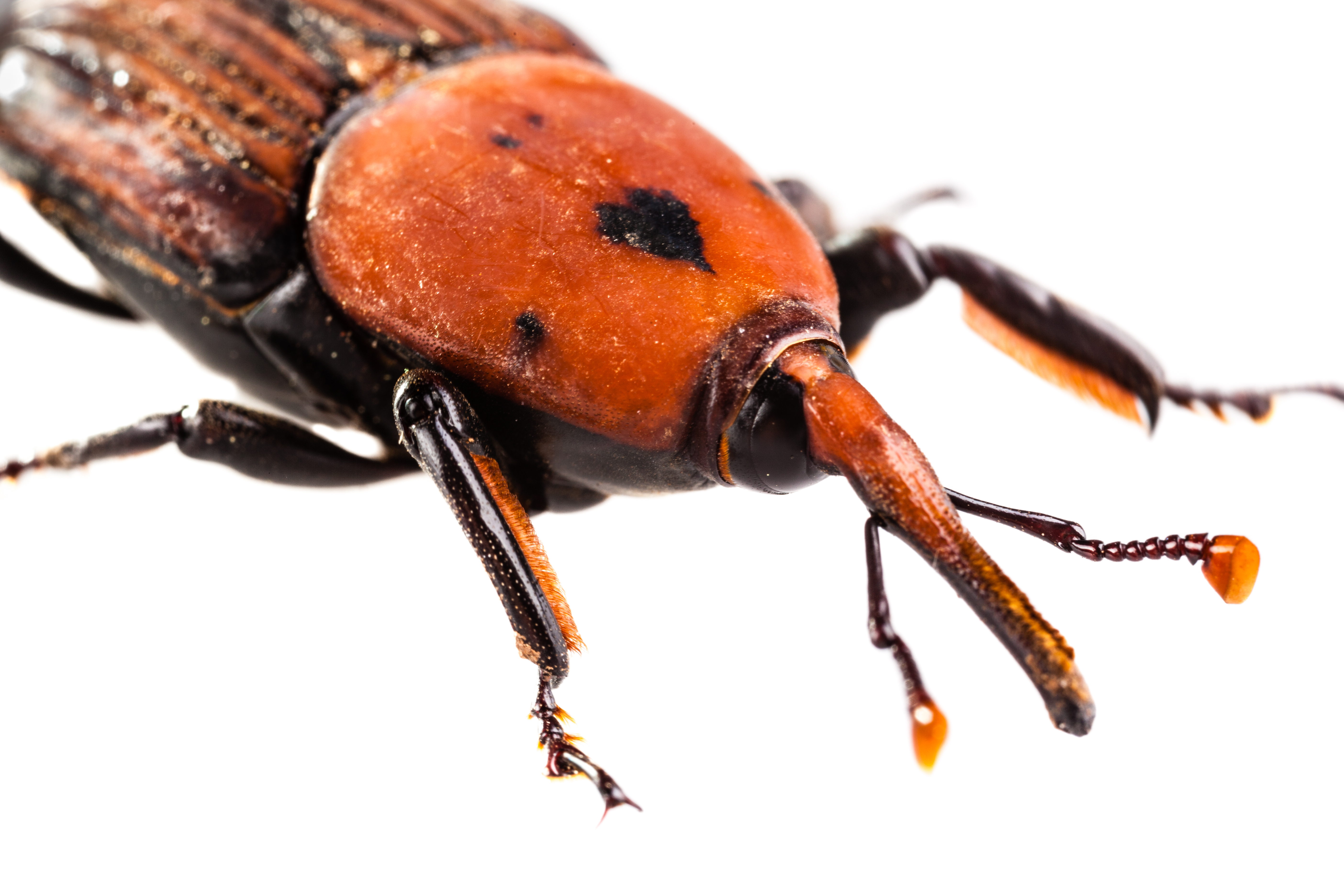
Is there something unwelcome lurking in your storage boxes?
Many insect and fungus invaders are potentially harmful to birds’ health, and there is also the secondary issue of grain parasites spreading to your own food supplies (flour, rice, etc). If you catch the problem early, you can salvage your supplies by freezing them in batches. This will kill the insects without harming the seed.
Pests - Beetles
Beetle intruders are often hard to spot. There are a dozen or so species of grain and seed infesters, and identifying the species is less important than taking immediate action. All types of grain beetle present the same problem – food spoilage – and a remedy for one type will work for all the others.
One of the most guilty culprits is the Saw-toothed grain beetle (Oryzaephilus surinamensis). At just 1 to 3 millimetres long, it’s not always immediately visible; but it flies, and can sniff out a sack of grain from several kilometres away, so grain can soon become infested.
Other common beetle freeloaders include the disarmingly named Confused flour beetle (Tribolium confusum), a 4 millimetre long brown insect with yellow-white larvae; and the similarly sized Rust-red flour beetle (Tribolium castaneum), which also infests stored spices and dried fruits.
Grain weevils (Sitophilus granarius) can become a problem too, along with their cousin the Rice weevil (Sitophilus oryzae). They have a characteristically long weevil ‘nose’, and grow up to 3 millimetres long. If your grains are not sealed in airtight containers, they’ll become a playground for these beetles. Check individual grains for tell-tale holes – this is where the weevil larvae has emerged.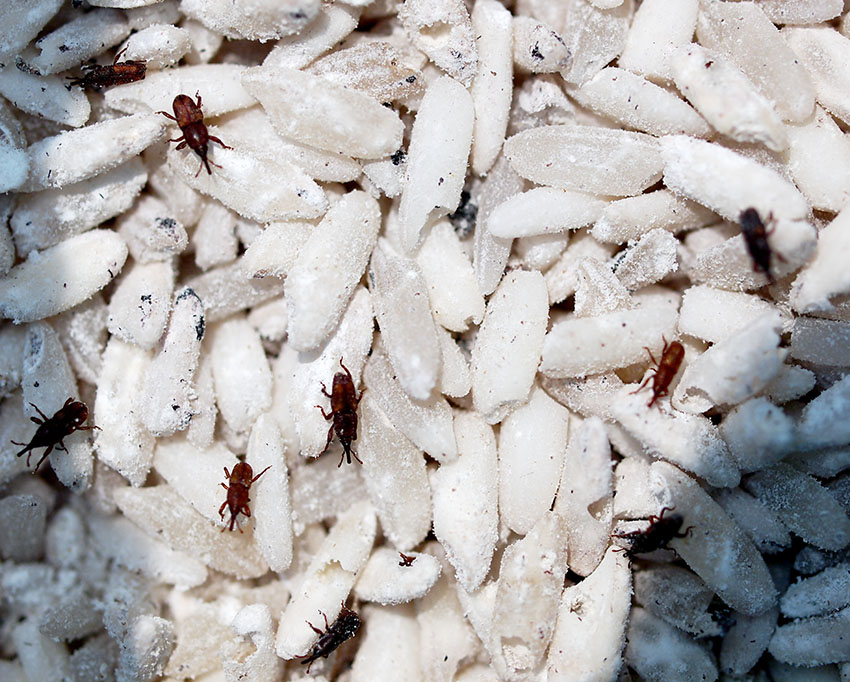
Grain and Rice weevils lay their eggs in bird food boxes, and their larvae gorge on the grain
If you catch the problem early, before the mouldy smell has set in and condemned the whole batch to the bin, you can freeze the seed in batches for 48 hours to kill the beetles. If weevils are the problem, take the seed from the freezer after 48 hours, leave it for two days, and then freeze again to polish off the survivors. Give your storage space a thorough clean in the meantime.
Pests - Moths
If thread-like structures appear in the grain, sticking them together like messy ethnic necklaces, you’re looking at the work of Grain moth larvae (Sitotroga cerealella). They spin a silk cocoon prior to transforming into adult moths.
Adult Grain moths, up to a centimetre long, may infest the grain too. Another, similarly sized culprit is the Brown house-moth (Hofmannophila pseudospretella). This is a common, small moth found in most houses throughout Europe. Both these moths lay lots of eggs, and a few weeks after they first flew in, there will be thousands of larvae in your food boxes. These light brown maggots with red-brown heads are the same size as the adults.
Some bird-keepers salvage moth-infested grain by freezing it for a couple of days to kill the intruders. The insects themselves are not toxic for budgies. This method is fine as long as the eggs have not hatched – if your seed has already reached the ‘thread-like structure’ stage, you won’t be able to salvage it.
Prevention is the best cure. If the finches are kept indoors, keep all surfaces clean, not forgetting to take the vacuum cleaner to any niches and corners where moths might hide out. You can also buy pheromone-based moth traps. If you opt to use these, keep them out of reach of free-flying birds, to avoid feathers getting gummed up on the traps’ sticky interior. A candle in a dark room will lure the unfortunate moths too. Some owners employ a less bloodthirsty herbal sachet deterrent, although this is more effective for the Common clothes moth (Tineola bisselliella) than for the grain moth. Recommended ingredients include bay leaves, cinnamon, cloves, eucalyptus, dried lemon peel, and black peppercorns.
Pests - Mites
If your supplies develop a mouldy smell with no obvious sign of beetles or moths, it could be down to mites. Flour mites (Acarus siro and Tyrophagus putrescentiae, usually) are the commonest culprits, and they are potentially deadly to finches if ingested. They’re tiny – tricky to spot in a small bag of flour, never mind a sack of grains. Some are even invisible to the naked eye. The mouldy smell is a giveaway, though.
To check for mites, put a pile of grains or seeds in a small bowl or cup, filling the vessel, and making the sides of the mound as steep as possible. If mites are present they will work through the grain in the bowl like earthworms in soil, flattening it out. There may be a few grains lying outside the bowl too. Sadly, there is no remedy other than ditching your supplies and cleaning your storage space.
Aviary Pests
If your finches are outdoors, it’s like a party invite for all kinds of invertebrate gate-crashers. The flies and wasps you can do nothing about, and they’re not such a problem. Ants are a different matter. They will be attracted to fresh food in the cages, and can reach plague proportions that can cause real problems, especially for nesting birds or chicks. If you are keeping insect-eating finches, they will assist in keeping ant numbers down.
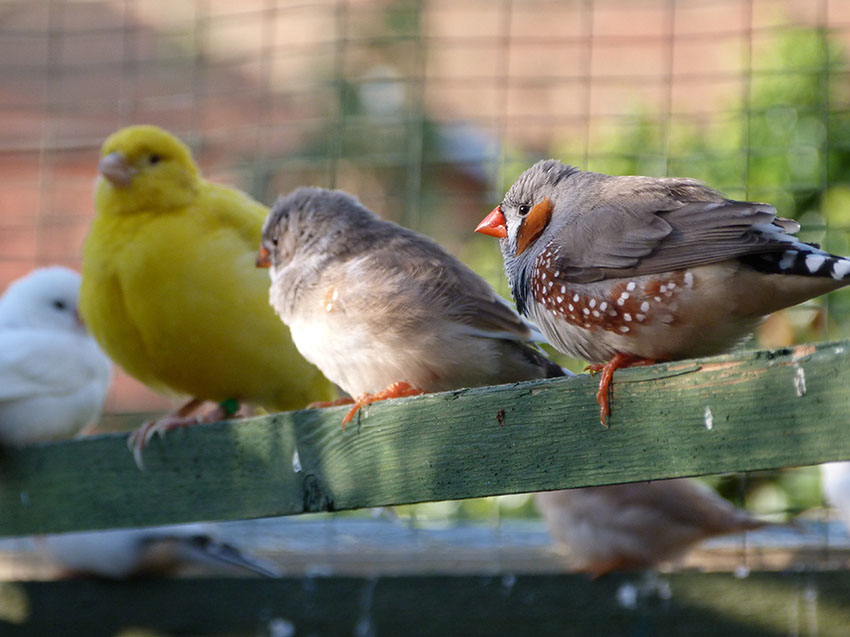
Aviaries can be prone to invasion by insects and other pests
Ant-zapping dust cannot be used safely in the aviary itself; although you can use it as a kind of chemical moat outside the cage. Some owners swear by the efficacy of cinnamon powder too, and this can be used safely inside the cage. It is also said to deter cockroach and garden beetle invaders. Similar claims have been made for powdered, bone meal, cayenne pepper, chalk, charcoal, coffee grounds and talcum (not the scented variety, which may upset birds’ stomachs). Cucumber peel has a mild deterrent effect too, so that’s also worth trying.
Another gentle approach to ant and beetle deterrents is to mix cider vinegar and water, or crushed garlic and water, and spray on the ants’ trail, and on any feeding station where they are congregated. Lemon juice is effective too. The spray will not harm the birds (as long as you don’t spray it on them directly). Infested fruit, etc, should be thrown away. Take a look an hour later and re-spray problem areas. If you can trace the ants back to their nest, you’ll be able to blast them with ant dust, or inflict a tsunami of boiling water on them. They’ll be back; but the goal here is to achieve as much prevention and damage limitation as possible in a world full of resilient ants.
Fruit flies (Drosophila) are another unwelcome guest, and if you spot one, you can guarantee a swarm of them in a couple of days. You can keep numbers down using fruit fly traps – place containers of wine or apple cider vinegar in the aviary. These should have lids with holes in, allowing the flies to enter, but making it hard for them to find their way out. It needs to be a lid that the finches cannot destroy. They won’t drink or be harmed by the contents, but they will release the prisoner flies. Some species - notably the Strawberry finch - actively hunt the flies, assisting you in your aviary cleansing efforts.
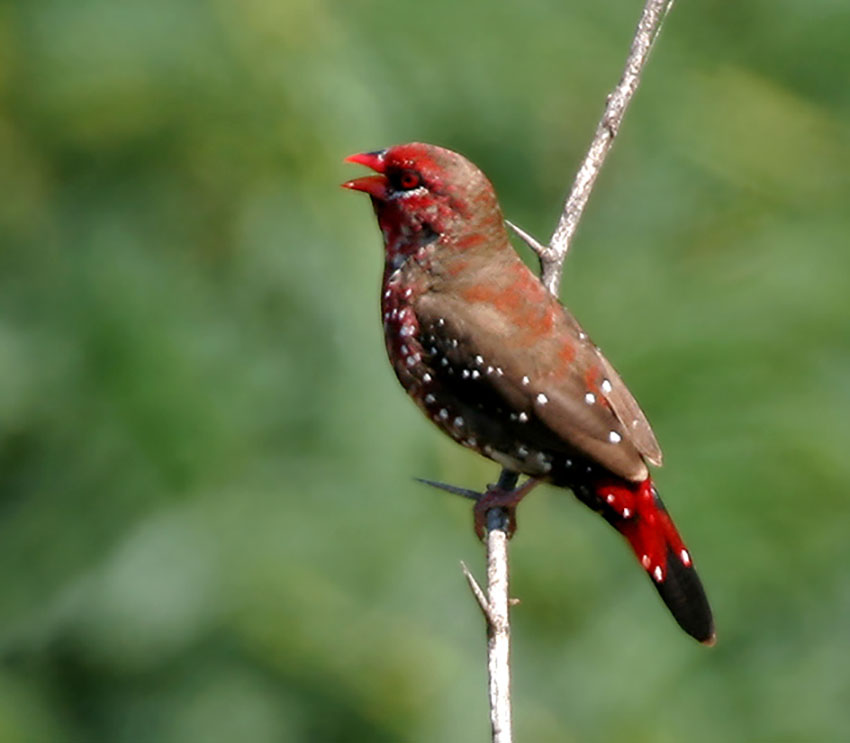
Strawberry finch - a handy fruit fly guzzler
If mosquitoes are a problem, you need to tackle it at the source. Mozzie larvae hatch out in standing water - open water butts, abandoned buckets, plant containers, garden ponds. Get rid of, or cover, all the water sources you can. A film of vegetable oil on an open water butt works too: the larvae cannot penetrate it to access air, and will drown. If the chief mosquito source is a garden pond, a population of goldfish or minnows will munch its way through the insect larvae, which will help.



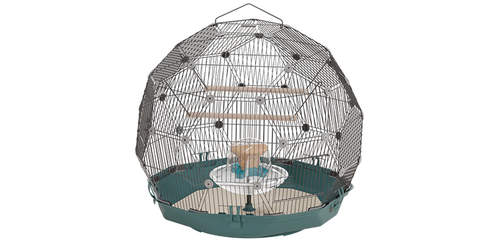
Comments
There are no comments just yet